The Mongol Rally is a harebrained idea that some English guys came up with in 2004. It is a 10,000-mile drive from London to Ulaanbaatar, Mongolia, with hundreds of cars full of equally mad people from around the world. There is no defined route. Teams are totally unsupported. The only rules are that you must use a car that is “complete rubbish” and you must donate at least £1,000 to charity.
We bought a tiny Suzuki Alto hatchback on eBay UK, and planned a route across western Europe and down through the Balkans, over the Anatolian plateau and into the Caucasus, across the Caspian Sea, through the deserts, mountain passes, and beautiful Silk Road cities of Central Asia, and finally over the barren Mongolian steppe to Ulaanbaatar. This required six different visas—a bureaucratic nightmare but worth it for the passport stickers.
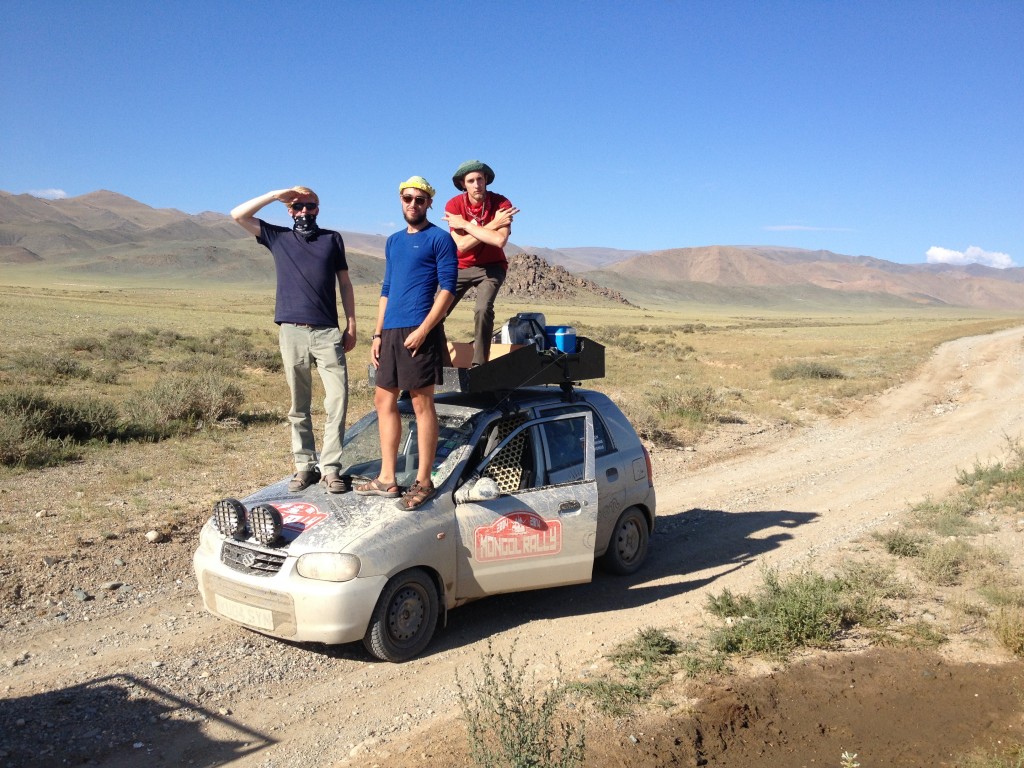
My teammates and me (giving the salute) on the “road” through western Mongolia.
We drove out of London on July 20, 2014 and six weeks later, we arrived in Ulaanbaatar under our own power (although our car’s suspension was completely destroyed). Quite a bit happened in between and you can see some highlights in the video below from the trip. But here I will simply point out a few discoveries and observations from the trip relating to brands, perceptions, and cultural differences.
Ulaanbaatar is the coldest and most polluted national capital in the world. It isn’t very pretty. The food is eminently mediocre, cultural offerings are minimal, infrastructure is poor. But for us after six weeks on the road—in particular the last week, which we spent on the Mongolian steppe over dirt roads or no roads at all, sleeping in tents, and passing perhaps one tiny village per day—Ulaanbaatar felt like a cosmopolitan oasis. We could sleep in proper beds with proper toilets and hot showers. There was a restaurant that served a bacon-and-eggs breakfast. And, of course, there was an Irish pub.
The Grand Khaan
We visited the Grand Khaan for dinner on our first night in Ulaanbaatar. Very far from home, giddy with the euphoria of having finished our great race, we initially had trouble deciding where we were going to have our celebratory dinner. Mongolia is not known for its food and so pub grub sounded pretty attractive. To be clear, we had relished all of the different cultural experiences we’d had on the road up to that point, but it was certainly a relief, if only for a few hours, to be back in the deep-fried bosom of the West.
On the streets of this city 10,000 miles overland from Ireland, the pub sticks out like my blonde hair. But everything inside—the food, the beer, the entire aesthetic of the place—seemed exactly right. I’ve never been to Ireland, but I have been to Irish pubs all over: New York, France, Portugal, and (earlier in the Mongol Rally) Baku, Azerbaijan. Every time it feels the same. Irish pubs are simulated realities; Baudrillard must have loved them.
My point is a simple one, but one that was made over and over again in striking fashion during the Rally: that context can transform a relatively ordinary experience into something remarkable.
It actually turns out that there’s more to this than you might think. Apparently the Irish have been literally exporting pubs around the world for decades. It’s very possible that in every one of the Irish pubs I’d visited, the stools I sat on, the light fixtures hanging from the ceilings, and the great wooden bars where I ordered my pints were all actually made on the Emerald Isle and then packed into shipping containers to be assembled in far flung locales around the world. The exportation of entire pubs seems to have began in the late ‘80s or early ‘90s. Before then, Irish immigrants opened pubs wherever they showed up, building them with local materials. They were simply bars with Irish names. But with the rise of Guinness as a global brand, and St. Patrick’s Day as an international drinking holiday, some Irish entrepreneurs realized that they could capitalize on the national brand and the national pastime.
One more thought on this. We all intuitively know that as human beings, our affective responses are heavily dependent on their context and our expectations. A more expensive bottle of wine is likely to taste better than a cheap one simply because of the price tag. And more choices can make us less likely to be satisfied. It seems that, for me at least, food tastes better when there are fewer options. It also tastes better when we are hungry, just as beds are more comfortable when we are tired. At the Grand Khaan we ordered plate after plate of greasy pub food and washed it down with Guinness. What would probably have been a forgettable meal back home was for us that evening a feast for the ages.
My point is a simple one, but one that was made over and over again in striking fashion during the Rally: that context can transform a relatively ordinary experience into something remarkable.
KFC
Earlier in the Rally, we were stuck for a few days in Baku, Azerbaijan. This was our departure point for a ferry across the Caspian Sea. Before going to the port, we had to get our Turkmenistan transit visas, but the embassy was in a barely marked building on a side street and had no address; we only found it thanks to GPS coordinates left by a previous Mongol Rally team. The ferry itself was in reality an aging cargo ship with some extra spots for passengers. It had no schedule, no official ticketing system, and very lax safety protocols. After arriving at the port, it took us 31 hours and several bribes to actually board the boat.
During our 31-hour wait at the port, we naturally had to eat. Simple American fast food seemed like the perfect antidote to our frustration, so obviously we went to KFC. McDonald’s may remain the most prominent American restaurant brand overall, but KFC has had remarkable success overseas. The Japanese love it, especially on Christmas, and it is the number one foreign restaurant brand in all of China. The KFC obsession is alive and well in Azerbaijan, too, which is immediately clear when you see its palatial restaurant in Baku, apparently the largest KFC in the world. It had ornate ceilings and two airy levels joined by a grand staircase. Out front was a large statue, probably of a former dictator though I’m not sure. Colonel Sanders smiled down on it. It was American culture in all its glory: breaded, deep-fried, and projected onto a huge, opulent former railway station in the sprawling capital of an oppressive, oil-rich country on the Caspian Sea.
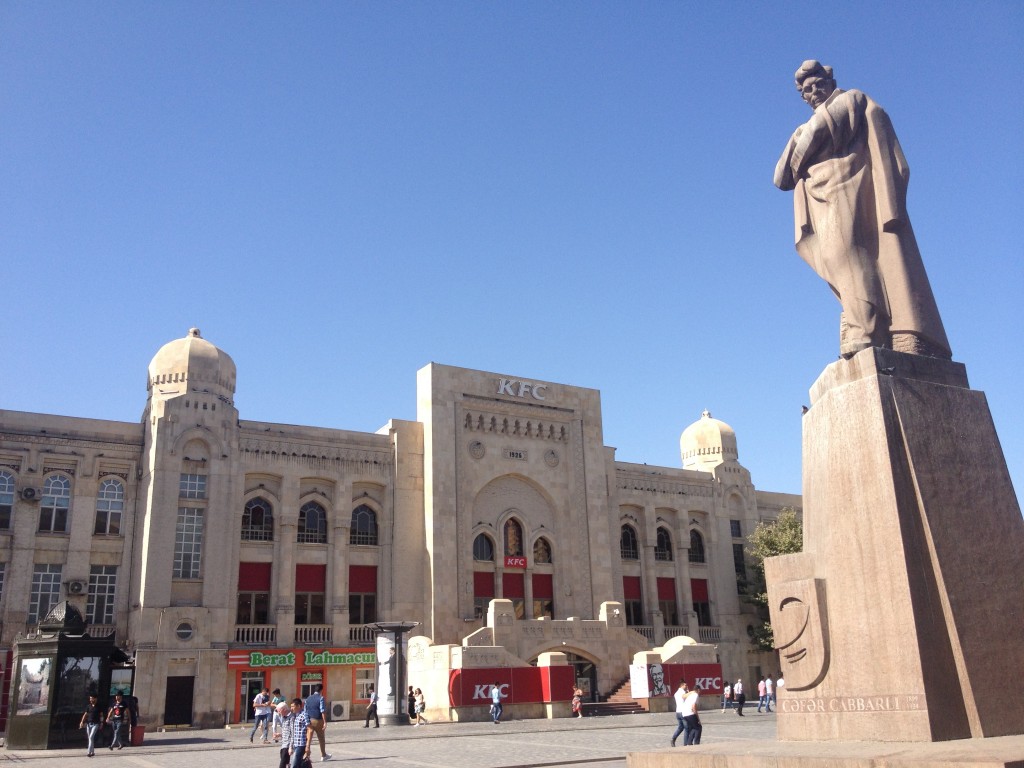
Communication and Hospitality
We learned many things on the Mongol Rally. For instance, we learned about what it is like to communicate with someone who does not share a single word with you. We tend to forget about the amount of communication that is nonverbal. As we drove further East, Russian slowly replaced English as the lingua franca, and we had to rely more and more on our eyes and hands and random noises. It’s a more primitive and, in a way, more intimate form of communication. I found myself looking more intently into the other person’s eyes and paying more attention to facial expressions than I do when I can use words. I thought about the extent to which this intimacy is being slowly eroded by emails and text messages.
We tend to forget about the amount of communication that is nonverbal.
We were consistently surprised by the level of hospitality we encountered on the road. One evening, driving through Georgia with two other Rally teams, we pulled off the road looking for a campsite. We found ourselves next to some run-down barns with sheep wandering about. Eventually a woman and her daughter came up to us and we managed to explain through gestures that we were hoping to find a place to set up our tents. She led us down a path to a small field bordered by a hedgerow, on the other side of which was a river. It was beautiful, mountainous countryside; the river was cold but refreshing and allowed us to wash some of our clothes. Later that evening the woman’s husband came down to the campsite, smiling and speaking incomprehensibly but beckoning to us to follow him. He led us up to their small house where his wife was cutting up watermelons and making coffee. We all sat around their kitchen table to eat and drink, smiling and nodding. In the corner the daughter was watching a Disney movie dubbed in Russian. We thanked them with a pack of Marlboro’s (American cigarettes are valuable currency; we had brought two cartons to give away) and went back to sleep by the river feeling wonderfully optimistic.
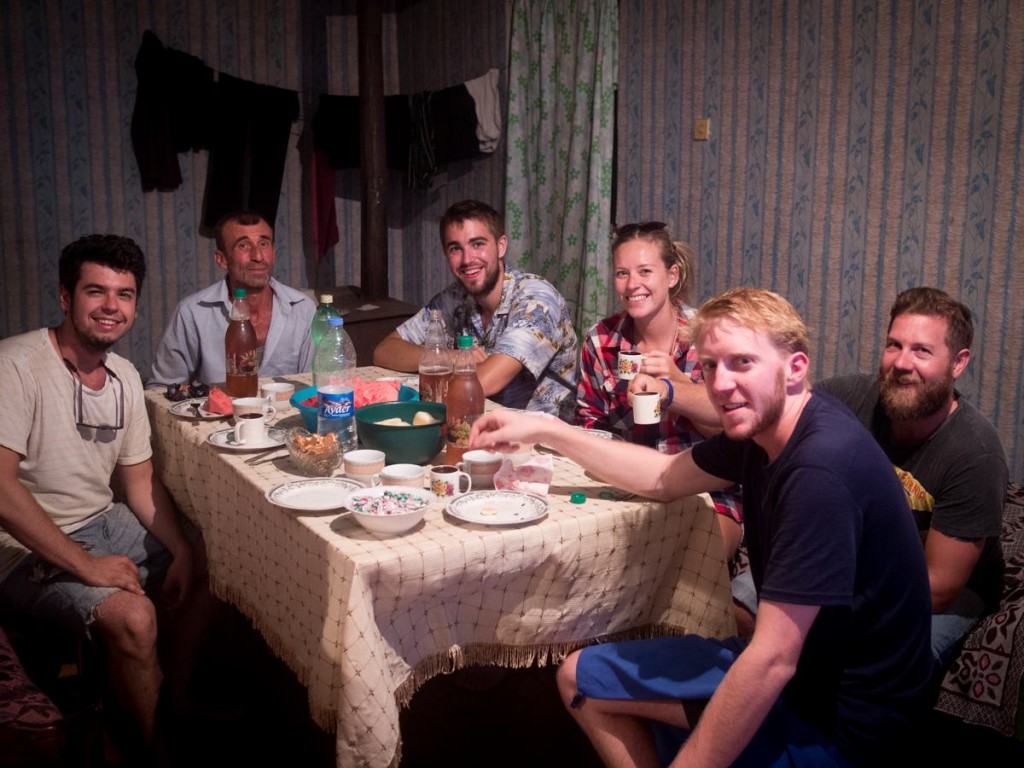 Sitting in the kitchen of our kind Georgian host.
Sitting in the kitchen of our kind Georgian host.
Other thoughts from the Mongol Rally experience
Life on the road was full of interesting and unexpected anecdotes. We awoke each day unsure of what awaited us. Early one morning in Samarkand, we bribed a policeman to let us climb up into the corner tower of one of the three old madrasas (Islamic schools) bordering the central square. The arabesque mosaics of gold and green and turquoise glowed in the morning light. It was truly a remarkable place to visit.
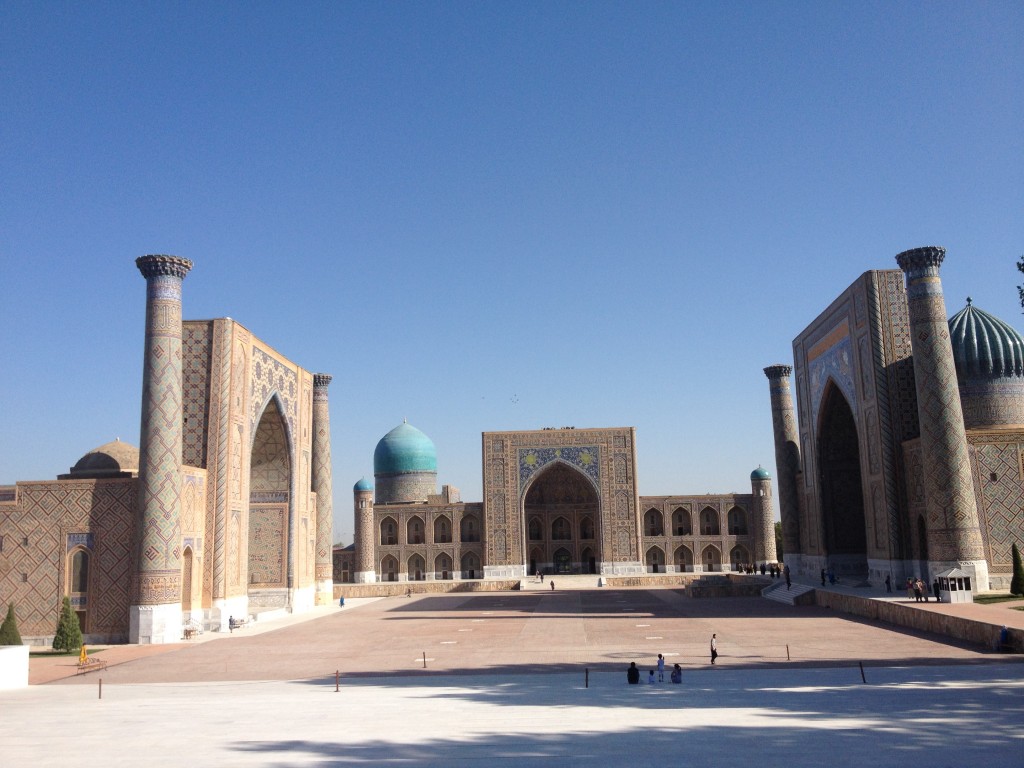
The central square of Samarkand, known as the Registan. The three madrasas were built between the 15th and 17th centuries.
In the Tian Shen mountains of Kyrgyzstan, a goat herder came out of her yurt to offer us some koumiss, or fermented mare’s milk. This is the Kyrgyz national beverage and refusing it is considered rude; unfortunately, I thought it tasted like bile.
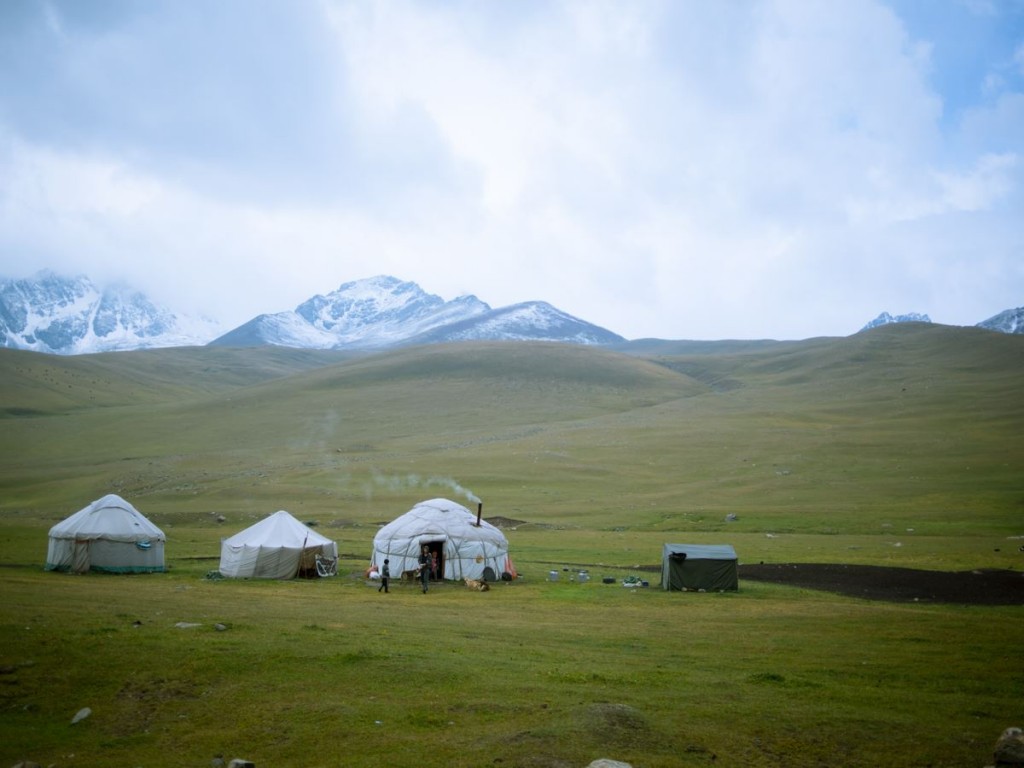
Our friendly herder’s yurt was the one with the chimney. The fires are fed with dung from the goats.
At the Mongolian border with Russia, we made friends with some border guards who took us out across the steppe in their Prius (complete with off-road tires) to hunt for marmots with a .22 rifle. Later that night, a local herder showed up at our campsite on a motorbike, chugged half a liter of vodka and then stripped to his underwear and demanded to fight one of the Danish guys on the Rally who we were caravanning with. Despite his drunkenness and smaller stature, our Mongolian visitor triumphed handily.
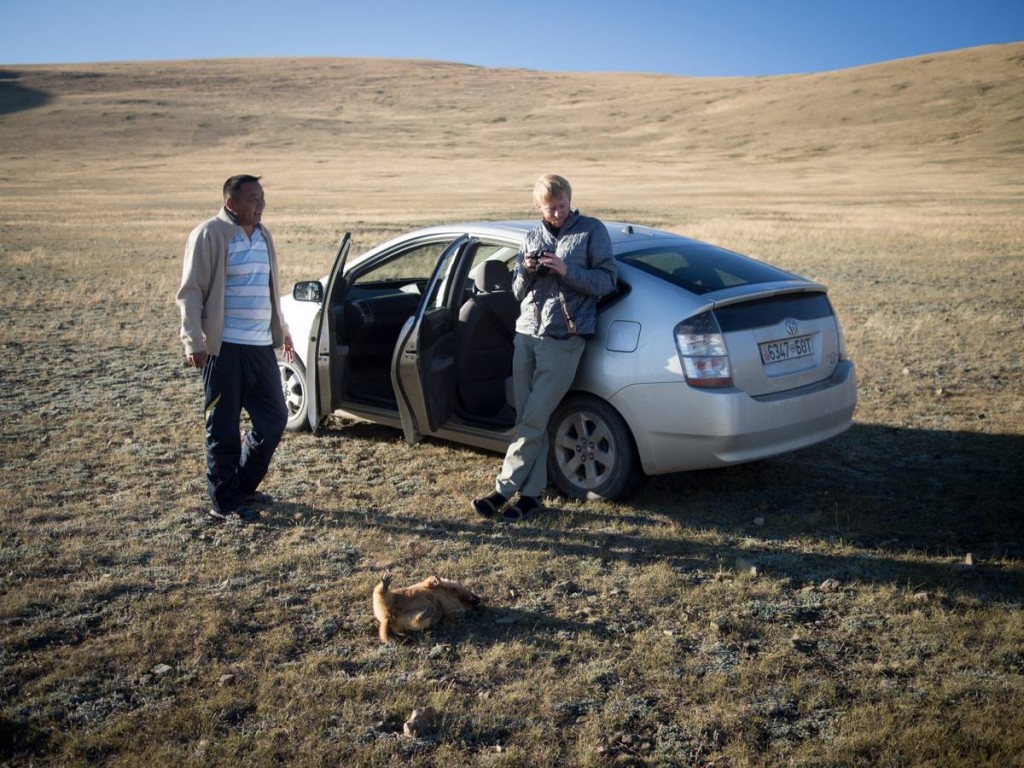
Here’s me with one of our Mongolian border guard friends and the first of our two victims.
We learned a lot about the unique challenges and pleasures of traveling by car. You can imagine most of the challenges: flat tires, leg cramps, border checkpoints, arguing about what music to listen to. Some other challenges were unexpected, like the fact that Uzbekistan was suffering from a massive fuel shortage, and we had to get through the country on black market gasoline which was unreliable and difficult to find.
Traveling by car may not be the most efficient method, but it allows you to see everything along the way. I thought of it as “The Great In-Between.”
But by and large the pleasures of traveling by car far outweighed the challenges. When you fly, you’re sort of like a gopher, popping up in a new location with no sense of what lies in between. Traveling by car may not be the most efficient method, but it allows you to see everything along the way. I thought of it as “The Great In-Between,” and I often found the unanticipated experiences in tiny towns or along the roadside to be more rewarding than the major checkpoints we passed through. It was incredibly freeing to wake up in the morning with no idea where we would end the day, only that we would go as far as we could or cared to and then pitch a tent. I miss the spontaneity of those six weeks on the road.
Of course, the constant uncertainty and the various demands of living out of a car for weeks on end were exhausting. I was relieved (and a bit surprised, to be honest) when we finished. I returned home feeling wonderfully refreshed and newly appreciative of little things. But even a year and a half later, not a day goes by without a vignette from the Mongol Rally swimming into my mind. I smile secure in the notion that whatever happens in my life hereafter, at least I made it to Ulaanbaatar.
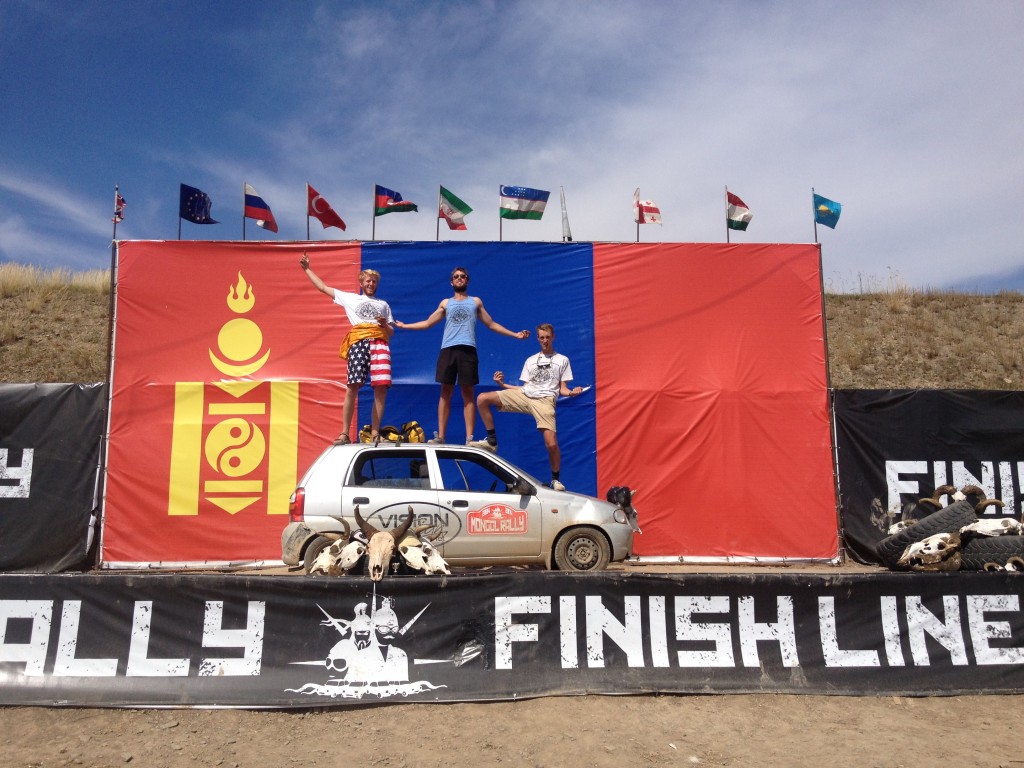
The finish line platform in Ulaanbaatar. Note the juxtaposition of my American Flag shorts and the golden sash I bought from a herder in a yurt in central Mongolia several days earlier.


Ask for help.
We are kind, thorough and ready when you are. You just need to ask.